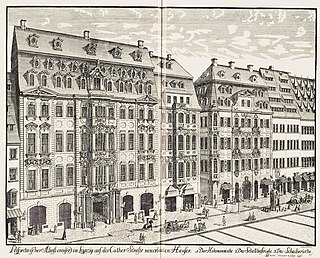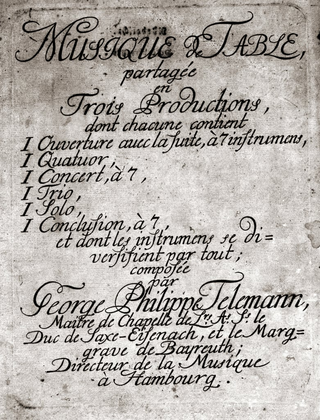Related Research Articles
The trio sonata is a genre, typically consisting of several movements, with two melody instruments and basso continuo. It originated in the early 17th century and was a favorite chamber ensemble combination in the Baroque era.

The Brandenburg Concertos by Johann Sebastian Bach are a collection of six instrumental works presented by Bach to Christian Ludwig, Margrave of Brandenburg-Schwedt, in 1721. The original French title is Six Concerts Avec plusieurs instruments, meaning "Six Concertos for several instruments". Some of the pieces feature several solo instruments in combination. They are widely regarded as some of the greatest orchestral compositions of the Baroque era.

Trevor David Pinnock is a British harpsichordist and conductor.

Francesco Maria Veracini was an Italian composer and violinist, perhaps best known for his sets of violin sonatas. As a composer, according to Manfred Bukofzer, "His individual, if not subjective, style has no precedent in baroque music and clearly heralds the end of the entire era", while Luigi Torchi maintained that "he rescued the imperiled music of the eighteenth century", His contemporary, Charles Burney, held that "he had certainly a great share of whim and caprice, but he built his freaks on a good foundation, being an excellent contrapuntist". The asteroid 10875 Veracini was named after him.

Gottfried Heinrich Stölzel was a German composer of the Baroque era.

In music, a trio is any of the following:
František Kočvara, known later in England as Frantisek Kotzwara, was a Czech violist, virtuoso double bassist and composer.
Pieter Hellendaal was a Dutch composer, organist and violinist.
Winfried Michel is a German recorder player, composer, and editor of music.

The Sonata in E major for flute and basso continuo is a sonata for transverse flute and figured bass composed by J. S. Bach in the 1740s. It was written as the result of a visit in 1741 to the court of Frederick the Great in Potsdam, where Bach's son Carl Philipp Emanuel had been appointed principal harpsichordist to the king the previous year. It was dedicated to Michael Gabriel Fredersdorf, the king's valet and private secretary, who, like the king, was an amateur flautist.
Alessandro Besozzi was an Italian composer and virtuoso oboist. He was a member of the ducal Guardia Irlandese from 1714, a hautboy band created by Antonio Farnese, Duke of Parma in 1702, where he worked with his father Cristoforo Besozzi and his brothers Giuseppe and Paolo Girolamo Besozzi. After leaving the company on 20 April 1731, he worked in Turin with his brother Paolo Girolamo at the court of Charles Emmanuel III of Sardinia.
Giovanni Benedetto Platti was born possibly 9 July 1697 in Padua, then belonging to Venice. He was an Italian Baroque composer and oboist. He died 11 January 1763 in Würzburg.

Johann Christian Schickhardt was a German composer and woodwind player.
Fitzwilliam Sonatas is the name first given by Thurston Dart to an arrangement he made, based on two recorder sonatas by George Frideric Handel, which he recast as a group of three sonatas. The term was applied by later editors to the original two sonatas as Handel wrote them, and was also expanded to encompass several other sonatas for various instruments included in the Handel autograph manuscripts held by the Fitzwilliam Museum in Cambridge.

The Sonata in G major for two flutes and basso continuo, BWV 1039, is a trio sonata by Johann Sebastian Bach. It is a version, for a different instrumentation, of the Gamba Sonata, BWV 1027. The first, second and fourth movement of these sonatas also exist as a trio sonata for organ.
Byron Schenkman is an American harpsichordist, pianist, music director, and educator. Schenkman has recorded over 40 CDs and has won several awards and accolades. He co-founded the Seattle Baroque Orchestra, and was its artistic director. Schenkman currently directs a baroque and classical chamber music concert series, Sound Salon, formerly Byron Schenkman & Friends, and performs as a recitalist and concert soloist. He also performs with chamber music ensembles, and is a teacher and lecturer.
Sonya Monosoff is a violinist, a pioneer of the Baroque violin and one of the first American performers to use the Baroque violin in performance.
Johann Pfeiffer was a German violinist, concert master and composer of the late baroque period.

Tafelmusik is a collection of instrumental compositions by Georg Philipp Telemann (1681–1767), published in 1733. The original title is Musique de table. The work is one of Telemann's most widely known compositions; it is the climax and at the same time one of the last examples of courtly table music.
References
- ↑ Mona Good, “An Interview with Daniel Waitzman,” The Flutist Quarterly, Vol. XIV, No. 1, Winter 1989, p. 48.
- ↑ "Bookshelf | Columbia College Today". www.college.columbia.edu. Retrieved 2022-06-15.
- ↑ Good.
- 1 2 Good, p. 50.
- 1 2 3 Sigrid Nagle, “Daniel Waitzman: A Profile," The American Recorder, Vol. 16, No. 2, May 1974, p. 48.
- ↑ https://www.discogs.com/Bernard-Krainis-The-Virtuoso-Recorder/release/1621112. Archived 2019-06-12 at the Wayback Machine
- ↑ Daniel Waitzman, “The Bell Key,” The American Recorder, Vol. IX, No. 1, pp. 3-4.
- ↑ Daniel R. Waitzman, Up from Authenticity, or How I Learned to Love the Metal Flute—A Personal Memoir, Amazon Kindle Book, 2012, loc. 324.
- 1 2 3 4 5 6 Waitzman, Up from Authenticity.
- ↑ Up from Authenticity, or How I Learned to Love the Metal Flute--A Personal Memoir. 16 November 2012. Retrieved May 1, 2017– via www.amazon.com.
- ↑ Donal Henahan, "Flexibility Can Be Authentic, Too," The New York Times, Sunday, July 22, 1990, Arts and Leisure (Sec. 2), pp. 1 ff.
- ↑ Daniel Waitzman, “Historical Versus Musical Authenticity: A Performer’s View,” The American Recorder, Vol. XXI, No. 1, May 1980, pp. 10-11. Also quoted in Geoffrey Burgess, Well-Tempered Woodwinds, Indiana University Press, 2015, p. 128.
- ↑ Good, p. 51.
- ↑ http://www.concertartists.org/competition-winners. Retrieved May 1, 2017. See also Nagle, p. 48.
- ↑ Brannen Brothers catalogue, 1974.
- ↑ Good, p. 53; Waitzman, Up From Authenticity, loc. 456.
- ↑ Raymond Ericson, “Amor Artis Presents Vivaldi With Verve,” The New York Times, December 23, 1976.
- ↑ Personal interview, May 3, 2017.
- ↑ Daniel Waitzman, The Art of Playing the Recorder, New York, AMS Press, 1978.
- ↑ Burgess, p. 79.
- ↑ Daniel Waitzman, "A Plan to Promote the Development of a Modernized Recorder," The American Recorder, Vol. XII, No. 3, August 1971, pp. 71-72.
- ↑ Burgess, pp. x-xi.
- ↑ Good, p. 49.
- ↑ Waitzman, Up from Authenticity, loc. 1161.
- ↑ Waitzman, Up from Authenticity, loc. 1141.
- ↑ Waitzman, Up from Authenticity, loc. 1085.